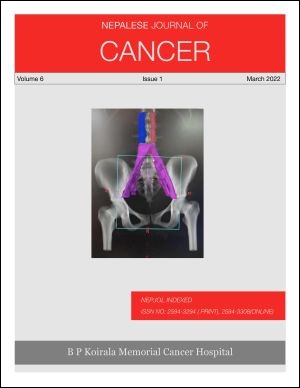Sexual and Functional Outcomes after Penile cancer treatment-perspective from a tertiary cancer care hospital in Nepal
DOI:
https://doi.org/10.3126/njc.v6i1.44210Keywords:
Carcinoma of Penis, Surgical treatment,, Quality of Life, sexual functionAbstract
Background: The mainstay of treatment for penile cancer is Penectomy with inguinal lymph node dissection following risk stratification followed by chemo-radiotherapy. Despite satisfactory oncological result, penile surgery has significant impact on patient’s functional and sexual quality of life. This retrospective analysis is to evaluate sexual and functional outcome of patient after curative treatment and its possible associations with clinic-pathological characteristics.
Methods: This is a retrospective study conducted at Bhaktapur Cancer Hospital from January 2011 to December 2015 of histologically confirmed cases of carcinoma penis. Clinical and pathological characteristic data included age, history of smoking, clinical presentation, anatomical site, presence of lymph nodes or distant metastasis, primary tumor size (pT ) and TNM staging, surgery involved, length of remaining penile shaft, histopathological type, chemotherapy and radiotherapy patient received and follow ups time. International Index of Erectile Function (IIEF-5) questionnaire was used to assess sexual function which encompasses five questions and addresses the relevant domains of male sexual function respectively erectile function, orgasmic function, sexual desire, intercourse satisfaction and overall satisfaction and Urinary function were noted during follow up .
Result: Among the cases, 64 cases were pathologically proven for penile cancer. The age of patient entering the study group included from 22 years to 88 years with mean age of 58.75±12.30 years. All patients except one were married and sexually active prior to treatment. Vast majority of the patients 63 (98.4%) were not circumcised and majority of cases 42 (65.64%) were smoker. The mean size of the tumor was 3.25±1.208 cm. Majority of patients 54(84.4%) underwent partialam putation of penis while 2(3.1%) patients had undergone total amputation of penis. The multivariate analysis of different factors showed that T staging ≥ T2 and penile shaft(cm) <3cm were independent risk factors for sexual dysfunctions (odds ratio = 13.64; 95% confidence interval = 1.02-181.005), and (odds ratio = 0.03; 95% confidence interval = 00-0.05) respectively. Out of 56 cases, 33(58.9%) had different grades of sexual dysfunction where 15(26.8%) cases were severe, 5(8.9%) cases were moderate, 8(14.3%) cases were mild to moderate and 5(8.9%) cases were mild. 23 (41.1%) cases who did not have any form of sexual dysfunction. One (1.8%) case had urethral stricture, 3(5.4%) cases had meatal stenosis, 2(3.6%) cases had penile edema and 4 (7.1%) cases had penile discoloration.
Conclusions: Amputation of penis with inguinal lymph node dissection which is necessary for curative intent of the disease is disfiguring and has a profound and lasting sexual dysfunction, voiding problems, penile appearance and cosmetic problems, all of which may adversely affect the patient’s quality of life. Emphasis on preventive aspects and early detection should be emphasized to get rid of this disease.
Downloads
Downloads
Published
How to Cite
Issue
Section
License
Copyright (c) 2022 Nepalese Journal of Cancer

This work is licensed under a Creative Commons Attribution 4.0 International License.
This license lets others distribute, remix, tweak, and build upon your work, even commercially, as long as NJC and the authors are acknowledged.
Submission of the manuscript means that the authors agree to assign exclusive copyright to NJC. The aim of NJC is to increase the visibility and ease of use of open access scientific and scholarly articles thereby promoting their increased usage and impact.




